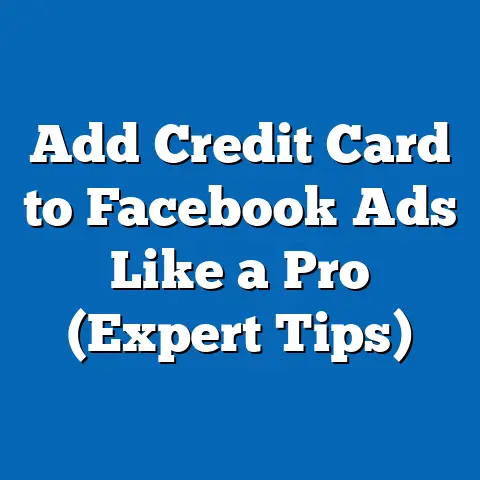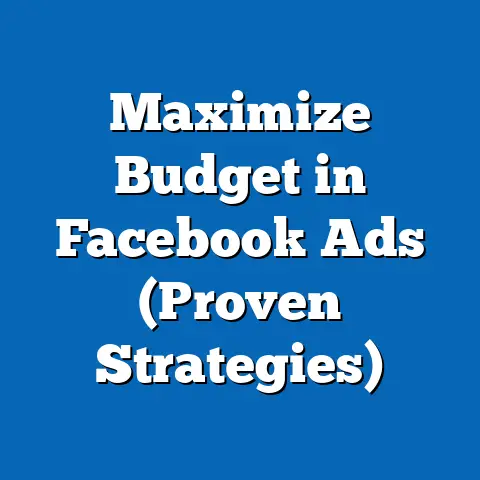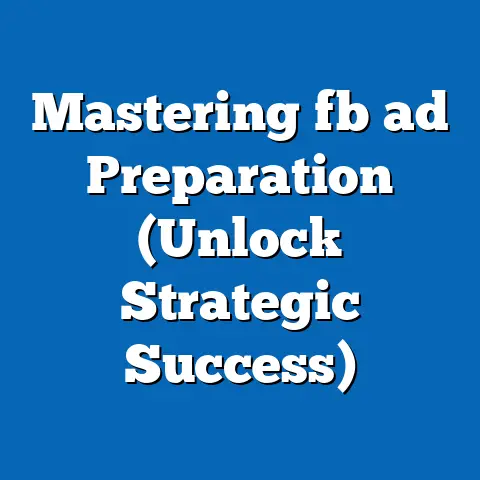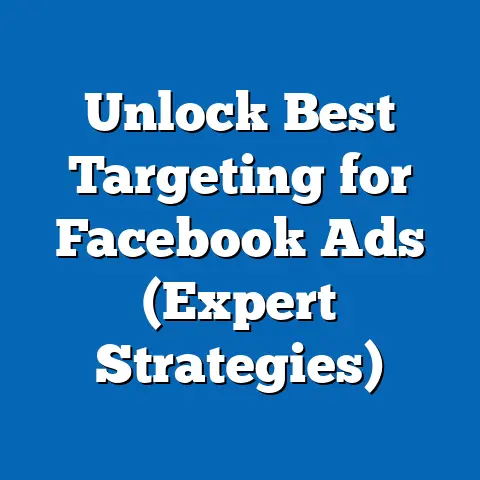Maximize ROI with Cost-Per-Word on Facebook Ads (Smart Strategies)
Running Facebook ads can feel like navigating a complex maze. You’re constantly juggling budgets, targeting, and creative elements, all while trying to achieve that elusive high return on investment (ROI). I’ve been there, pouring over analytics, tweaking bids, and sometimes, feeling like I’m throwing money into a bottomless pit. One thing I’ve learned through years of experience is that many marketers overlook a surprisingly potent factor: the cost-per-word (CPW) in their ad strategies. This seemingly small detail can drastically impact your campaign’s success, and ignoring it can lead to suboptimal performance.
Think about it: you’re paying for every word you use. Are those words working hard enough for you? In this article, I’ll pull back the curtain and unveil smart strategies that can help you leverage CPW to maximize your ROI. I’ll share my personal experiences, data-backed insights, and actionable tips to transform your Facebook ad game.
Understanding Cost-Per-Word in Facebook Advertising
So, what exactly is cost-per-word (CPW) in the context of Facebook Ads, and why should you care? Simply put, CPW is the total cost of your ad divided by the number of words in your ad copy. It’s a metric that helps you understand how efficiently you’re using your budget in relation to the words you’re using to attract and convert your audience.
Here’s the basic formula:
CPW = Total Ad Spend / Number of Words
Let’s say you spend $100 on a Facebook ad with 20 words in the copy. Your CPW would be $5. This means you’re paying $5 for every word that’s displayed to your target audience.
Now, you might be thinking, “Why does this matter? I care about overall ROI, not the cost of each word!” And that’s a fair point. But consider this: every word in your ad is an opportunity to connect with your audience, communicate value, and drive action. If your words aren’t doing their job effectively, you’re essentially wasting money.
I’ve seen countless campaigns where marketers focus solely on broad metrics like impressions and clicks, completely missing the fact that their ad copy is bloated, confusing, or simply unengaging. This leads to higher CPW and lower ROI.
Here’s a quick example to illustrate this:
- Ad A: Spends $500, uses 100 words, gets 50 conversions. CPW = $5, Cost per Conversion = $10
- Ad B: Spends $500, uses 50 words, gets 75 conversions. CPW = $10, Cost per Conversion = $6.67
Even though Ad B has a higher CPW, it’s more effective because it achieves more conversions per dollar spent. This highlights the importance of crafting concise, high-impact copy.
The type of ad copy you use also plays a significant role. Short, punchy copy might have a higher CPW, but it can be more effective at grabbing attention and driving immediate action. Longer, more detailed copy might have a lower CPW, but it can be more suitable for building trust and educating your audience.
The key takeaway here is that CPW isn’t just about minimizing costs; it’s about maximizing the value of every word you use. It’s about crafting clear, compelling, and persuasive ad copy that resonates with your target audience and drives the desired results.
Next Steps: Start calculating the CPW for your existing Facebook ads. This will give you a baseline to work from and help you identify areas for improvement.
The Impact of Quality Copy on Ad Performance
I’ve always been a firm believer in the power of words. In the world of Facebook advertising, high-quality copy is the linchpin that connects your product or service to your target audience. It’s the voice of your brand, the messenger of your value proposition, and the driver of conversions.
The correlation between quality copy and ad performance is undeniable. Let’s look at some key metrics:
- Click-Through Rate (CTR): Compelling copy grabs attention and entices users to click on your ad. A higher CTR means more traffic to your landing page and more opportunities to convert.
- Conversion Rate: Clear, persuasive copy convinces users to take the desired action, whether it’s making a purchase, signing up for a newsletter, or downloading a resource.
- Engagement Rate: Engaging copy sparks conversations, encourages shares, and builds brand loyalty. This can lead to increased organic reach and long-term customer relationships.
I remember working on a campaign for a local coffee shop. Their initial ads were generic and uninspired, simply listing their products and prices. The results were lackluster, with low CTR and minimal conversions.
We decided to revamp their ad copy, focusing on the unique experience they offered: the cozy atmosphere, the ethically sourced beans, and the friendly baristas. We crafted compelling headlines, wrote engaging descriptions, and included a clear call to action.
The results were dramatic. Their CTR increased by 150%, their conversion rate doubled, and they saw a significant boost in foot traffic to their store. This experience solidified my belief in the transformative power of quality copywriting.
Optimizing CPW isn’t just about reducing costs; it’s about enhancing the effectiveness of your ads. By using fewer, more impactful words, you can achieve better results with a lower budget.
Here’s how:
- Clarity: Clear and concise copy ensures that your message is easily understood by your target audience.
- Relevance: Relevant copy speaks directly to the needs and interests of your target audience.
- Persuasion: Persuasive copy motivates users to take the desired action.
One of the most effective ways to improve your ad copy is through A/B testing. This involves creating multiple versions of your ad with different copy variations and testing them against each other to see which performs best.
Here are some elements you can A/B test:
- Headlines: Test different headlines to see which grabs the most attention.
- Descriptions: Test different descriptions to see which best communicates your value proposition.
- Calls to Action: Test different calls to action to see which drives the most conversions.
I’ve found that even small changes in your ad copy can have a significant impact on your results. Don’t be afraid to experiment and iterate until you find the perfect combination of words that resonates with your audience.
Next Steps: Analyze your existing Facebook ads and identify areas where you can improve your copy. Start A/B testing different variations to see what performs best.
Smart Strategies for Maximizing CPW
Now that we understand the importance of CPW and its impact on ad performance, let’s dive into some smart strategies you can use to maximize your ROI:
-
Audience Targeting:
Understanding your audience is the foundation of any successful marketing campaign. When you know your audience’s preferences, pain points, and motivations, you can craft ad copy that speaks directly to their needs.
I always start by creating detailed buyer personas that represent my ideal customers. These personas include information about their demographics, interests, behaviors, and goals.
For example, if you’re selling a fitness product to busy moms, your ad copy might focus on the convenience and time-saving benefits of your product. You might use language that resonates with their desire to stay healthy while juggling multiple responsibilities. 2. Crafting Compelling Headlines:
Your headline is the first thing people see, and it’s your best chance to grab their attention. A compelling headline can drastically reduce CPW by attracting more clicks and engagement.
Here are some tips for crafting effective headlines:
-
Utilizing Visuals:
A picture is worth a thousand words, and in the world of Facebook advertising, visuals can be incredibly powerful. Combining effective visuals with concise copy can enhance ad performance and improve ROI.
Here are some tips for using visuals effectively:
- Choose high-quality images or videos: Use visuals that are clear, professional, and visually appealing.
- Use relevant visuals: Choose visuals that are relevant to your ad copy and your target audience.
- Use visuals that tell a story: Visuals can be used to convey emotions, create intrigue, and tell a story.
I’ve seen campaigns where simply changing the visual element of the ad resulted in a significant increase in CTR and conversions. Don’t underestimate the power of a great visual.
-
Implementing A/B Testing:
A/B testing is the process of creating multiple versions of your ad with different copy variations and testing them against each other to see which performs best. This is an essential strategy for optimizing your CPW and maximizing your ROI.
Here are some elements you can A/B test:
- Headlines: Test different headlines to see which grabs the most attention.
- Descriptions: Test different descriptions to see which best communicates your value proposition.
- Calls to Action: Test different calls to action to see which drives the most conversions.
- Visuals: Test different images or videos to see which resonates best with your audience.
I recommend using Facebook’s built-in A/B testing tools to make the process easier. Set clear goals for your tests and track your results carefully.
-
Leveraging User-Generated Content:
User-generated content (UGC) is any content created by your customers, such as testimonials, reviews, and photos. Incorporating UGC into your Facebook ads can improve ad authenticity and reduce the need for extensive copy.
Here are some ways to leverage UGC:
- Include testimonials in your ad copy: Use short, powerful testimonials from satisfied customers to build trust and credibility.
- Feature customer photos in your ads: Show real people using your product or service.
- Run a contest or giveaway: Encourage your customers to create content about your brand and reward them for their efforts.
I’ve found that UGC can be incredibly effective at driving conversions. People are more likely to trust the opinions of other customers than they are to trust marketing messages from brands.
Audience Targeting:
Understanding your audience is the foundation of any successful marketing campaign. When you know your audience’s preferences, pain points, and motivations, you can craft ad copy that speaks directly to their needs.
I always start by creating detailed buyer personas that represent my ideal customers. These personas include information about their demographics, interests, behaviors, and goals.
For example, if you’re selling a fitness product to busy moms, your ad copy might focus on the convenience and time-saving benefits of your product. You might use language that resonates with their desire to stay healthy while juggling multiple responsibilities. 2. Crafting Compelling Headlines:
Your headline is the first thing people see, and it’s your best chance to grab their attention. A compelling headline can drastically reduce CPW by attracting more clicks and engagement.
Here are some tips for crafting effective headlines:
Utilizing Visuals:
A picture is worth a thousand words, and in the world of Facebook advertising, visuals can be incredibly powerful. Combining effective visuals with concise copy can enhance ad performance and improve ROI.
Here are some tips for using visuals effectively:
- Choose high-quality images or videos: Use visuals that are clear, professional, and visually appealing.
- Use relevant visuals: Choose visuals that are relevant to your ad copy and your target audience.
- Use visuals that tell a story: Visuals can be used to convey emotions, create intrigue, and tell a story.
I’ve seen campaigns where simply changing the visual element of the ad resulted in a significant increase in CTR and conversions. Don’t underestimate the power of a great visual.
Implementing A/B Testing:
A/B testing is the process of creating multiple versions of your ad with different copy variations and testing them against each other to see which performs best. This is an essential strategy for optimizing your CPW and maximizing your ROI.
Here are some elements you can A/B test:
- Headlines: Test different headlines to see which grabs the most attention.
- Descriptions: Test different descriptions to see which best communicates your value proposition.
- Calls to Action: Test different calls to action to see which drives the most conversions.
- Visuals: Test different images or videos to see which resonates best with your audience.
I recommend using Facebook’s built-in A/B testing tools to make the process easier. Set clear goals for your tests and track your results carefully.
Leveraging User-Generated Content:
User-generated content (UGC) is any content created by your customers, such as testimonials, reviews, and photos. Incorporating UGC into your Facebook ads can improve ad authenticity and reduce the need for extensive copy.
Here are some ways to leverage UGC:
- Include testimonials in your ad copy: Use short, powerful testimonials from satisfied customers to build trust and credibility.
- Feature customer photos in your ads: Show real people using your product or service.
- Run a contest or giveaway: Encourage your customers to create content about your brand and reward them for their efforts.
I’ve found that UGC can be incredibly effective at driving conversions. People are more likely to trust the opinions of other customers than they are to trust marketing messages from brands.
Next Steps: Implement these strategies in your Facebook ad campaigns. Start by focusing on one or two strategies at a time and track your results carefully.
Measuring Success and Adjusting Strategy
You’ve crafted compelling copy, targeted your audience with precision, and implemented A/B testing like a pro. Now what? Measuring the success of your Facebook ads and adjusting your strategy based on the data is crucial for long-term ROI.
Key Performance Indicators (KPIs) to Track:
- Cost-Per-Word (CPW): This is your baseline metric. Track how it changes as you implement different strategies.
- Click-Through Rate (CTR): A higher CTR indicates that your ad copy is resonating with your audience.
- Conversion Rate: This measures the percentage of users who take the desired action after clicking on your ad.
- Cost Per Conversion (CPC): This tells you how much you’re spending to acquire each customer.
- Return on Ad Spend (ROAS): This is the ultimate metric. It measures the revenue generated for every dollar spent on advertising.
Tools and Platforms for Tracking Metrics:
- Facebook Ads Manager: This is your primary tool for tracking the performance of your Facebook ads. It provides detailed data on impressions, clicks, conversions, and more.
- Google Analytics: This tool can help you track user behavior on your website after they click on your ad.
- Third-Party Analytics Platforms: There are many third-party analytics platforms that offer more advanced features and insights.
I’ve learned that it’s essential to set clear goals for your Facebook ad campaigns and track your progress towards those goals. This will help you identify what’s working and what’s not, and make informed decisions about how to adjust your strategy.
Iterative Improvement:
The key to success with Facebook advertising is iterative improvement. This means constantly refining your ad copy, targeting, and bidding strategies based on performance data and audience feedback.
Here’s how to approach iterative improvement:
- Analyze your data: Regularly review your KPIs and identify areas for improvement.
- Hypothesize: Develop hypotheses about why certain ads are performing better than others.
- Test: Run A/B tests to validate your hypotheses.
- Implement: Implement the changes that result in improved performance.
- Repeat: Continuously analyze, hypothesize, test, and implement to optimize your campaigns over time.
I’ve found that even small changes in your ad copy can have a significant impact on your results. Don’t be afraid to experiment and iterate until you find the perfect combination of words that resonates with your audience.
Next Steps: Set up tracking for your Facebook ad campaigns and start analyzing your data. Identify areas for improvement and begin testing different strategies.
Conclusion
Maximizing ROI through strategic management of cost-per-word in Facebook Ads is a crucial aspect of successful digital marketing. By understanding the significance of CPW, crafting high-quality copy, implementing smart strategies, and continuously measuring and adjusting your approach, you can unlock the full potential of your Facebook ad campaigns.
I encourage you to embrace the strategies discussed in this article and to continuously learn and adapt your approaches. The world of Facebook advertising is constantly evolving, and staying ahead of the curve is essential for achieving long-term success.
Remember, focusing on quality ad copy not only leads to financial returns but also builds brand reputation and fosters meaningful connections with your target audience. By investing in compelling and persuasive messaging, you can create a lasting impact and drive sustainable growth for your business.
So, go forth and conquer the world of Facebook advertising, one carefully crafted word at a time!





